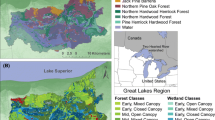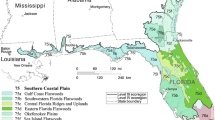Abstract
This article is an extension and application of Preston and Bedford (1988), especially as relevant to bottomland hardwood (BLH) forests of the southeastern United States. The most important cumulative effects in BLH forests result from incremental forest loss (nibbling) and from synergisms resulting from this nibbling. Present regulatory procedures are ineffective in preventing incremental forest loss because of the focus on permit site evaluation, rather than on large landscapes. Three examples are given to illustrate the need for a landscape focus. This perspective requires preplanning or goal-setting to establish the desired conditions to be maintained in the regulated landscape unit.
Spatial and temporal scales are of particular concern for landscape impact assessment. Natural drainage basins of about 106 ha, as identified in U.S. Geological Survey hydrologic units, appear to appropriate spatial units: they have fairly natural boundaries, are of sufficient size to support populations of large, wide-ranging mammals, and are compatible with existing maps and databases. Time scales should be sufficiently long to include recovery of wetland ecosystems from human perturbations. In practice, available data sets limit analysis to no longer than 50 yr. Eight indicators of landscape integrity are identified, based on generally available long-term data sets.
Linking technical information concerning cumulativeeffects on landscapes to the evaluation of cumulativeimpacts in regulatory programs (i.e., goal-setting) is a serious issue that can benefit from precedents found in the field of epidemiology, and in the establishment of clean air and clean water standards. We suggest that reference data sets must be developed, relating BLH function to structure (forest area). These can be used to set goals for individual watersheds, based on their present conditions and the magnitude and type of perceived development pressures. Thus the crucial steps in establishing a successful program appear to be (1) establish study unit boundaries, (2) assess the condition of study unit landscape integrity, (3) set goals, and (4) consider the impacts of permit proposals with both goals and the existing condition of the study unit landscape in mind.
Similar content being viewed by others
Literature cited
Adamus, P. R., E. J. Clairain, R. D. Smith, and R. E. Young. 1987. Wetland evaluation technique (WET), vol. II. Operating Draft TR Y-87. U.S. Army Engineers, Waterways Experiment Station, Vicksburg, Mississippi, 196 pp.
Adamus, P. R., and L. Stockwell. 1983. A method for wedand functional assessment, vol. I Critical review and evaluation concepts. U.S. Federal Highway Administration report FHWA-IP-82-23. National Technical Information Service, Springfield, Virginia, 176 pp.
Beanlands, G. E., and P. N. Duinker. 1983. An ecological framework for environmental impact assessment in Canada. Institute for Resource and Environmental Studies, Dalhousie University, Halifax and Federal Environmental Assessment Review Office, Hull, Quebec, Canada.
Belt, C. B., Jr. 1975. The 1973 flood and man's construction of the Mississippi River.Science 189:681–684.
Brinson, M. M. 1988. Strategies for assessing the cumulative effects of wetland alteration on water quality.Environmental Management 12(5):655–662.
Brinson, M. M., J. Day, J. Gosselink, W. Kruczynski, R. Lea, W. Mitsch, J. Safley, M. Scott, and G. Auble. 1985. Ecosystem processes workgroup report. Pages 100–132in J. E. Roelle, G. T. Auble, D. B. Hamilton, R. L. Johnson, and C. A. Segelquist (eds.), Results of a workshop concerning ecological zonation in bottomland hardwoods. U.S. Fish and Wildlife Service report WELUT-85/W. Western Energy and Land Use Team, Ft. Collins, Colorado, 146 pp.
Council on Environmental Quality. 1978. Regulations for implementing the procedural provisions of the National Environmental Policy Act. 40 CFR 1508.7.
Diamond, J. M. 1975. The island dilemma: lessons of modern biogeographic studies for the design of natural reserves.Biological Conservation 7:129–146.
Gosselink, J. G., J. Dowhan, L. Harris, P. Hatcher, R. Johnson, B. Keeler, R. Lea, L. Lee, L. Pearlstein, D. Sanders, L. Tebo, and G. Auble. 1986. Cumulative Impacts Workgroup report. Pages 94–112in J. E. Roelle, G. T. Auble, D. B. Hamilton, G. C. Horak, R. L. Johnson, and C. A. Segelquist (eds.), Results of a workshop concerning impacts of various activities on the functions of bottomland hardwoods. U.S Fish and Wildlife Service report WELUT-85/W, U.S Fish and Wildlife Service, Ft. Collins, CO.
Gosselink, J. G., and L. C. Lee. 1987. Cumulative impact assessment in bottomland hardwood forests. Report LSUCEI-86-09, Center for Wetland Resources, Louisiana State University, Baton Rouge, Louisiana, 112 pp.
Gosselink, J. G., and L. C. Lee. 1988. Cumulative impact assessment principles.In Proceedings of the National Symposium On Wedand Mitigation, October 8–10 1986, New Orleans, Louisiana. Association of State Wetland Managers, Chester, Vermont, in press.
Harris, L. D. 1984. The fragmented forest: island biogeography theory and the preservation of biotic diversity. University of Chicago Press, Chicago, Illinois, 211 pp.
Harris, L. D., and J. G. Gosselink. 1988. Cumulative impacts of bottomland hardwood conversion on wildlife, hydrology, and water quality.In J. G. Gosselink, L. C. Lee, and T. A. Muir (eds.), Bottomland hardwood wedands: results of EPA-sponsored workshops. U.S. EPA Office of Wetlands Protection, Washington, D.C., in review.
Hefner, J. M., and J. D. Brown. 1984. Wetland trends in the southeastern United States.Wetlands 4:1–12.
Hirsch, A. 1988. The regulatory context for cumulative impact research.Environmental Management 12(5):715–723.
Lee, L. C., C. Rhodes, J. Day, J. Gosselink, L. Harris, C. Kiker, R. Lea, J. Pomponio, and G. Auble. 1986. Cumulative impacts workgoup report.In J. E. Roelle, G. T. Auble, D. B. Hamilton, R. L. Johnson, and C. A. Segelquist (eds.), Results of a workshop on impact assessment in bottomland hardwood forests. U.S. Fish and Wildlife Service report WELUT-86AV, U.S. Fish and Wildlife Service, Washington, D.C.
MacArthur, R. H., and E. O. Wilson. 1967. The theory of island biogeography. Princeton University Press, Princeton, New Jersey.
Margoulis, C., and M. B. Usher. 1981. Criteria used in assessing wildlife conservation potential: a review.Biological Conservation 21:79–109.
McCabe, C. A., H. D. Hall, and R. C. Barkley. 1981. Yazoo area pump study, Yazoo backwater project, Mississippi. U.S. Fish and Wildlife Service, Jackson, Mississippi, unpublished report.
Preston, E. M., and B. L. Bedford. 1988. Evaluation cumulative effects on wetland functions: a conceptual overview and generic framework.Environmental Management 12(5):565–583.
Ter Braak, C. J. 1986. Canonical correspondence analysis: a new eigenvector technique for multivariate direct gradient analysis.Ecology 67:1167–1179.
Tiner, R. W. 1984. Wetlands of the United States: current status and recent trends. National Wetlands Inventory 1984-439-855-814/10870, U.S. Fish and Wildlife Service, Washington, D.C., 59 pp.
U.S. Environmental Protection Agency. 1980. Guidelines for specification of disposal sites for dredged and fill material. U.S. EPA, Washington, D.C., 40 CFR 320.
U.S. Environmental Protection Agency. 1986. Final determination of the Assistant Administrator for External Affairs concerning the Sweedens Swamp site in Attleboro, Mass., Pursuant to Section 404(c) of the Clean Water Act. Document H-119, Washington, D.C., 32 pp. plus appendixes.
Author information
Authors and Affiliations
Rights and permissions
About this article
Cite this article
Lee, L.C., Gosselink, J.G. Cumulative impacts on wetlands: Linking scientific assessments and regulatory alternatives. Environmental Management 12, 591–602 (1988). https://doi.org/10.1007/BF01867538
Issue Date:
DOI: https://doi.org/10.1007/BF01867538




